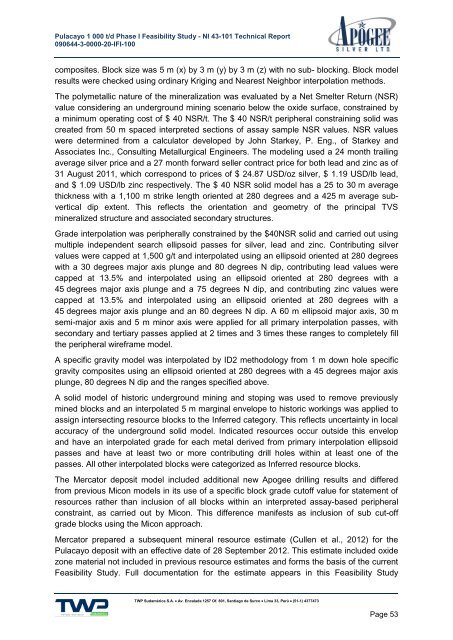Pulacayo Project Feasibility Study - Apogee Silver
Pulacayo Project Feasibility Study - Apogee Silver
Pulacayo Project Feasibility Study - Apogee Silver
You also want an ePaper? Increase the reach of your titles
YUMPU automatically turns print PDFs into web optimized ePapers that Google loves.
<strong>Pulacayo</strong> 1 000 t/d Phase I <strong>Feasibility</strong> <strong>Study</strong> - NI 43-101 Technical Report<br />
090644-3-0000-20-IFI-100<br />
composites. Block size was 5 m (x) by 3 m (y) by 3 m (z) with no sub- blocking. Block model<br />
results were checked using ordinary Kriging and Nearest Neighbor interpolation methods.<br />
The polymetallic nature of the mineralization was evaluated by a Net Smelter Return (NSR)<br />
value considering an underground mining scenario below the oxide surface, constrained by<br />
a minimum operating cost of $ 40 NSR/t. The $ 40 NSR/t peripheral constraining solid was<br />
created from 50 m spaced interpreted sections of assay sample NSR values. NSR values<br />
were determined from a calculator developed by John Starkey, P. Eng., of Starkey and<br />
Associates Inc., Consulting Metallurgical Engineers. The modeling used a 24 month trailing<br />
average silver price and a 27 month forward seller contract price for both lead and zinc as of<br />
31 August 2011, which correspond to prices of $ 24.87 USD/oz silver, $ 1.19 USD/lb lead,<br />
and $ 1.09 USD/lb zinc respectively. The $ 40 NSR solid model has a 25 to 30 m average<br />
thickness with a 1,100 m strike length oriented at 280 degrees and a 425 m average subvertical<br />
dip extent. This reflects the orientation and geometry of the principal TVS<br />
mineralized structure and associated secondary structures.<br />
Grade interpolation was peripherally constrained by the $40NSR solid and carried out using<br />
multiple independent search ellipsoid passes for silver, lead and zinc. Contributing silver<br />
values were capped at 1,500 g/t and interpolated using an ellipsoid oriented at 280 degrees<br />
with a 30 degrees major axis plunge and 80 degrees N dip, contributing lead values were<br />
capped at 13.5% and interpolated using an ellipsoid oriented at 280 degrees with a<br />
45 degrees major axis plunge and a 75 degrees N dip, and contributing zinc values were<br />
capped at 13.5% and interpolated using an ellipsoid oriented at 280 degrees with a<br />
45 degrees major axis plunge and an 80 degrees N dip. A 60 m ellipsoid major axis, 30 m<br />
semi-major axis and 5 m minor axis were applied for all primary interpolation passes, with<br />
secondary and tertiary passes applied at 2 times and 3 times these ranges to completely fill<br />
the peripheral wireframe model.<br />
A specific gravity model was interpolated by ID2 methodology from 1 m down hole specific<br />
gravity composites using an ellipsoid oriented at 280 degrees with a 45 degrees major axis<br />
plunge, 80 degrees N dip and the ranges specified above.<br />
A solid model of historic underground mining and stoping was used to remove previously<br />
mined blocks and an interpolated 5 m marginal envelope to historic workings was applied to<br />
assign intersecting resource blocks to the Inferred category. This reflects uncertainty in local<br />
accuracy of the underground solid model. Indicated resources occur outside this envelop<br />
and have an interpolated grade for each metal derived from primary interpolation ellipsoid<br />
passes and have at least two or more contributing drill holes within at least one of the<br />
passes. All other interpolated blocks were categorized as Inferred resource blocks.<br />
The Mercator deposit model included additional new <strong>Apogee</strong> drilling results and differed<br />
from previous Micon models in its use of a specific block grade cutoff value for statement of<br />
resources rather than inclusion of all blocks within an interpreted assay-based peripheral<br />
constraint, as carried out by Micon. This difference manifests as inclusion of sub cut-off<br />
grade blocks using the Micon approach.<br />
Mercator prepared a subsequent mineral resource estimate (Cullen et al., 2012) for the<br />
<strong>Pulacayo</strong> deposit with an effective date of 28 September 2012. This estimate included oxide<br />
zone material not included in previous resource estimates and forms the basis of the current<br />
<strong>Feasibility</strong> <strong>Study</strong>. Full documentation for the estimate appears in this <strong>Feasibility</strong> <strong>Study</strong><br />
TWP Sudamérica S.A. Av. Encalada 1257 Of. 801, Santiago de Surco Lima 33, Perú (51-1) 4377473<br />
Page 53



